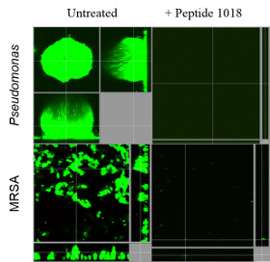Biofilm defense: Mechanisms and actions of a new class of broad-spectrum antimicrobials

Last month WHO issued a report that warned of an increase of antimicrobial-resistance and the renewed threat of bacterial infections world-wide and called for a concerted effort to develop new and better antimicrobial drugs. A study published on May 22nd in PLOS Pathogens reveals how a new type of anti-microbial substance interferes with biofilms formed by several dangerous bacteria.
When growing on surfaces (including human skin, lung, heart, or bladder) many bacteria form so-called biofilms that consist of structured communities of identical bacteria. 65% of human infections are caused by biofilms, and in this configuration bacteria are much more resistant to standard antibiotics. Bob Hancock, from the University of British Columbia, Canada, and colleagues, are working on antimicrobials that inhibit bacterial biofilms. At the center of this study is "1018", a small protein (or peptide) with anti-biofilm activity against a range of different bacteria.
At concentrations that did not affect the "planktonic growth" of free-swimming bacteria, 1018 treatment completely prevented biofilm formation and eradicated mature biofilms in both Gram-negative and Gram-positive bacteria, including the major resistant pathogens Pseudomonas aeruginosa, Klebsiella pneumoniae, Escherichia coli, and methicillin resistant Staphylococcus aureus (or MRSA).
In their quest to understand the mechanism by which 1018 kills bacteria, and specifically those in biofilms, the researchers reasoned that it had to interfere with a process that was common to different bacterial species. One such process is the wide-spread "stringent stress response" that uses specific mediators called (p)ppGpp to orchestrate the expression of a plethora of genes that help bacteria to cope with changing environments. The scientists hypothesized that 1018 (and possibly other anti-biofilm factors) acted by blocking the stringent response.
They went on to test this by over-producing the mediator (p)ppGpp in biofilm-forming bacteria, and the fact that this made the bacteria more resistant to 1018 suggested that they were on the right track. They then went on to demonstrate that 1018 directly and specifically interacts with (p)ppGpp, triggers the destruction of the mediator, and thereby prevents its role in biofilm formation and maintenance.
The researchers conclude that "the strategy presented here represents a significant advance in the search for new agents that specifically target bacterial biofilms". On this basis, they are working to "take advantage of the opportunity to now develop more active peptides that have even more potent anti-biofilm activity".
















